warning FIAT DOBLO COMBI 2018 Owner handbook (in English)
[x] Cancel search | Manufacturer: FIAT, Model Year: 2018, Model line: DOBLO COMBI, Model: FIAT DOBLO COMBI 2018Pages: 272, PDF Size: 23.75 MB
Page 87 of 272
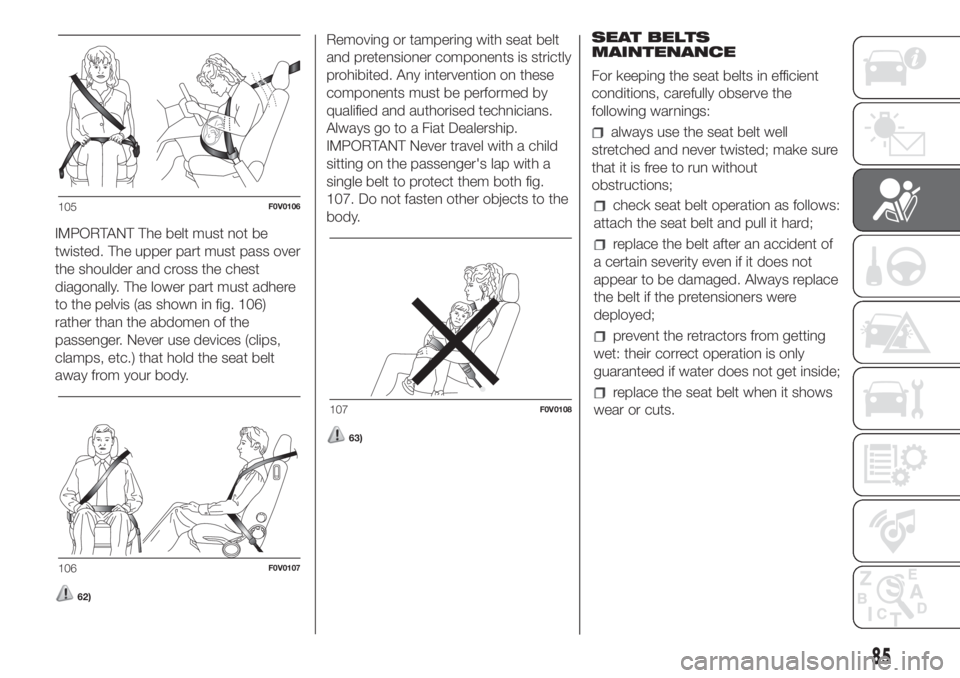
85
IMPORTANT The belt must not be
twisted. The upper part must pass over
the shoulder and cross the chest
diagonally. The lower part must adhere
to the pelvis (as shown in fig. 106)
rather than the abdomen of the
passenger. Never use devices (clips,
clamps, etc.) that hold the seat belt
away from your body.
62)
Removing or tampering with seat belt
and pretensioner components is strictly
prohibited. Any intervention on these
components must be performed by
qualified and authorised technicians.
Always go to a Fiat Dealership.
IMPORTANT Never travel with a child
sitting on the passenger's lap with a
single belt to protect them both fig.
107. Do not fasten other objects to the
body.
63)
SEAT BELTS
MAINTENANCE
For keeping the seat belts in efficient
conditions, carefully observe the
following warnings:
always use the seat belt well
stretched and never twisted; make sure
that it is free to run without
obstructions;
105F0V0106
106F0V0107
107F0V0108
check seat belt operation as follows:
attach the seat belt and pull it hard;
replace the belt after an accident of
a certain severity even if it does not
appear to be damaged. Always replace
the belt if the pretensioners were
deployed;
prevent the retractors from getting
wet: their correct operation is only
guaranteed if water does not get inside;
replace the seat belt when it shows
wear or cuts.
Page 88 of 272
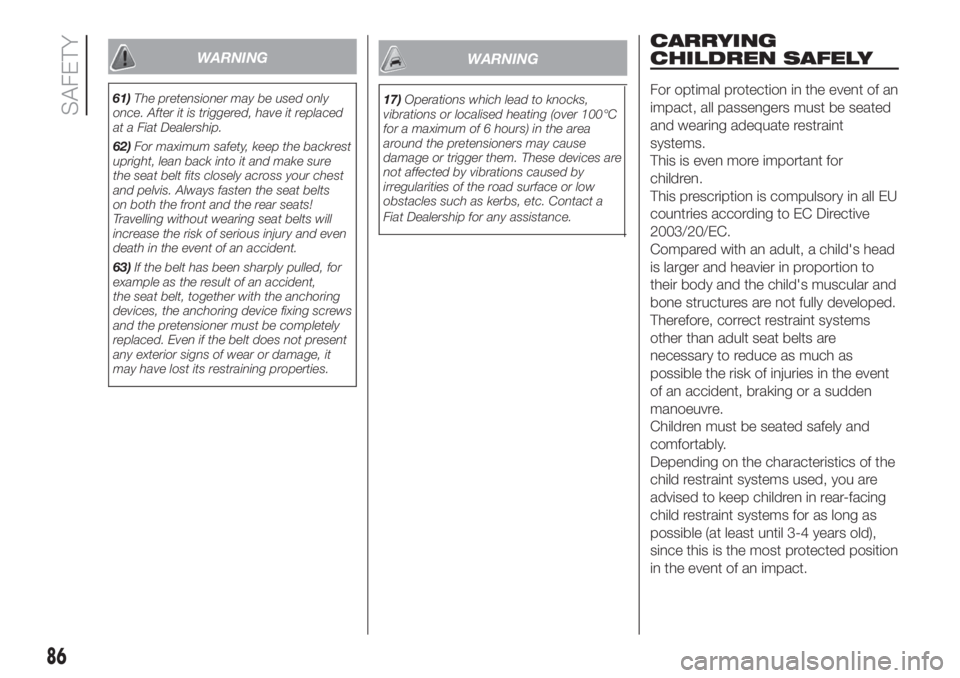
CARRYING
CHILDREN SAFELY
For optimal protection in the event of an
impact, all passengers must be seated
and wearing adequate restraint
systems.
This is even more important for
children.
This prescription is compulsory in all EU
countries according to EC Directive
2003/20/EC.
Compared with an adult, a child's head
is larger and heavier in proportion to
their body and the child's muscular and
bone structures are not fully developed.
Therefore, correct restraint systems
other than adult seat belts are
necessary to reduce as much as
possible the risk of injuries in the event
of an accident, braking or a sudden
manoeuvre.
Children must be seated safely and
comfortably.
Depending on the characteristics of the
child restraint systems used, you are
advised to keep children in rear-facing
child restraint systems for as long as
possible (at least until 3-4 years old),
since this is the most protected position
in the event of an impact.
86
SAFETY
WARNING
61)The pretensioner may be used only
once. After it is triggered, have it replaced
at a Fiat Dealership.
62)For maximum safety, keep the backrest
upright, lean back into it and make sure
the seat belt fits closely across your chest
and pelvis. Always fasten the seat belts
on both the front and the rear seats!
Travelling without wearing seat belts will
increase the risk of serious injury and even
death in the event of an accident.
63)If the belt has been sharply pulled, for
example as the result of an accident,
the seat belt, together with the anchoring
devices, the anchoring device fixing screws
and the pretensioner must be completely
replaced. Even if the belt does not present
any exterior signs of wear or damage, it
may have lost its restraining properties.
WARNING
17)Operations which lead to knocks,
vibrations or localised heating (over 100°C
for a maximum of 6 hours) in the area
around the pretensioners may cause
damage or trigger them. These devices are
not affected by vibrations caused by
irregularities of the road surface or low
obstacles such as kerbs, etc. Contact a
Fiat Dealership for any assistance.
Page 91 of 272
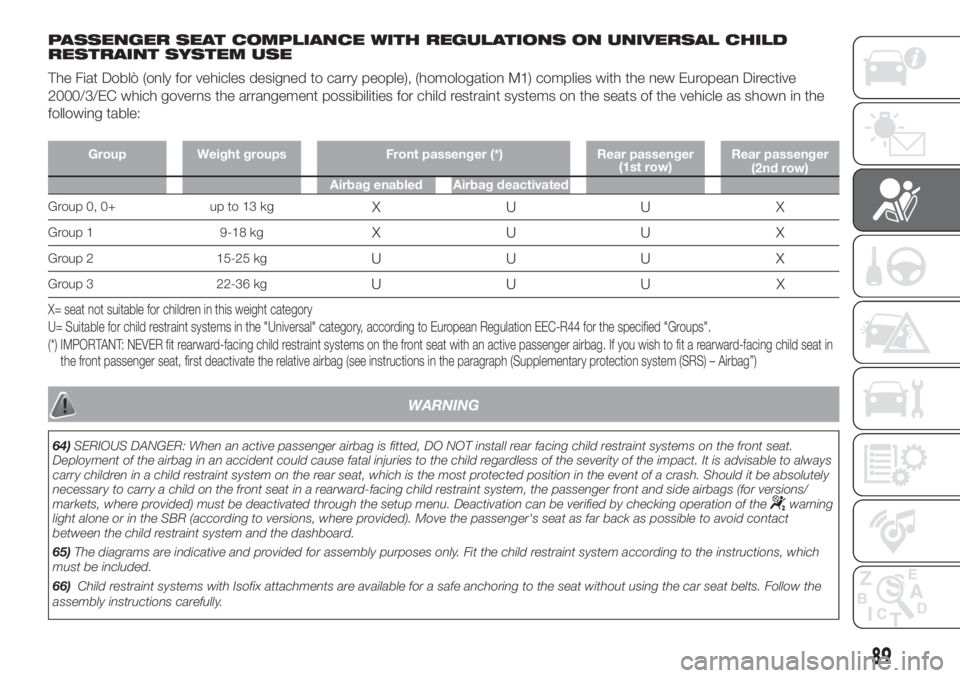
PASSENGER SEAT COMPLIANCE WITH REGULATIONS ON UNIVERSAL CHILD
RESTRAINT SYSTEM USE
The Fiat Doblò (only for vehicles designed to carry people), (homologation M1) complies with the new European Directive
2000/3/EC which governs the arrangement possibilities for child restraint systems on the seats of the vehicle as shown in the
following table:
Group Weight groups Front passenger (*) Rear passenger
(1st row)Rear passenger
(2nd row)
Airbag enabled Airbag deactivated
Group 0, 0+ up to 13 kgXUUX
Group 1 9-18 kgXUUX
Group 2 15-25 kgUUU X
Group 3 22-36 kgUUU X
X= seat not suitable for children in this weight category
U= Suitable for child restraint systems in the "Universal" category, according to European Regulation EEC-R44 for the specified "Groups".
(*) IMPORTANT: NEVER fit rearward-facing child restraint systems on the front seat with an active passenger airbag. If you wish to fit a rearward-facing child seat in
the front passenger seat, first deactivate the relative airbag (see instructions in the paragraph (Supplementary protection system (SRS) – Airbag”)
WARNING
64)SERIOUS DANGER: When an active passenger airbag is fitted, DO NOT install rear facing child restraint systems on the front seat.
Deployment of the airbag in an accident could cause fatal injuries to the child regardless of the severity of the impact. It is advisable to always
carry children in a child restraint system on the rear seat, which is the most protected position in the event of a crash. Should it be absolutely
necessary to carry a child on the front seat in a rearward-facing child restraint system, the passenger front and side airbags (for versions/
markets, where provided) must be deactivated through the setup menu. Deactivation can be verified by checking operation of the
warning
light alone or in the SBR (according to versions, where provided). Move the passenger's seat as far back as possible to avoid contact
between the child restraint system and the dashboard.
65)The diagrams are indicative and provided for assembly purposes only. Fit the child restraint system according to the instructions, which
must be included.
66)Child restraint systems with Isofix attachments are available for a safe anchoring to the seat without using the car seat belts. Follow the
assembly instructions carefully.
89
Page 97 of 272
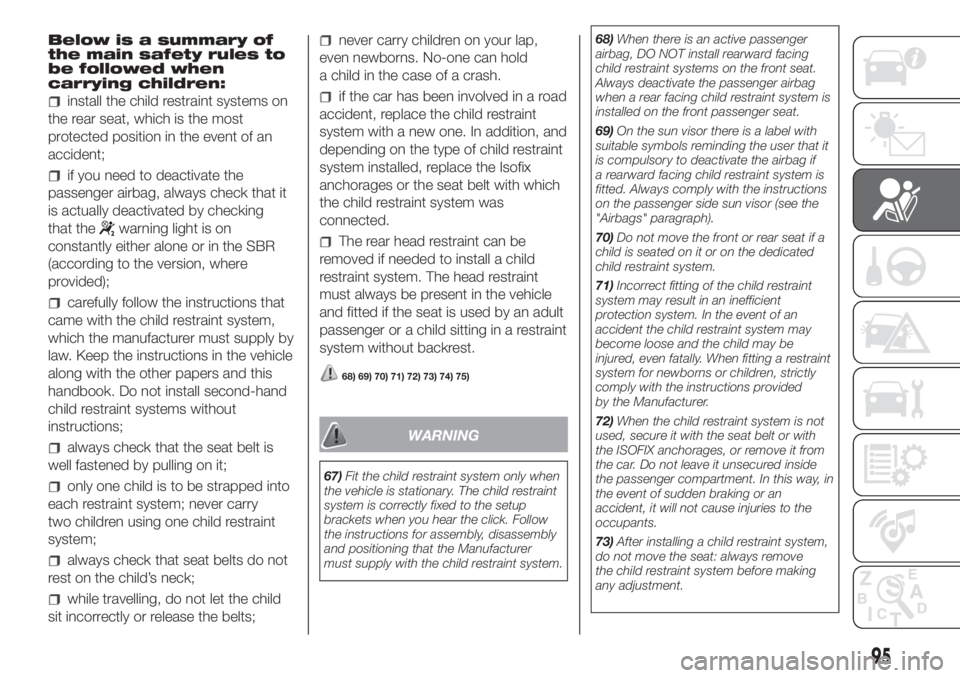
Below is a summary of
the main safety rules to
be followed when
carrying children:
install the child restraint systems on
the rear seat, which is the most
protected position in the event of an
accident;
if you need to deactivate the
passenger airbag, always check that it
is actually deactivated by checking
that the
warning light is on
constantly either alone or in the SBR
(according to the version, where
provided);
carefully follow the instructions that
came with the child restraint system,
which the manufacturer must supply by
law. Keep the instructions in the vehicle
along with the other papers and this
handbook. Do not install second-hand
child restraint systems without
instructions;
always check that the seat belt is
well fastened by pulling on it;
only one child is to be strapped into
each restraint system; never carry
two children using one child restraint
system;
always check that seat belts do not
rest on the child’s neck;
while travelling, do not let the child
sit incorrectly or release the belts;
never carry children on your lap,
even newborns. No-one can hold
a child in the case of a crash.
if the car has been involved in a road
accident, replace the child restraint
system with a new one. In addition, and
depending on the type of child restraint
system installed, replace the Isofix
anchorages or the seat belt with which
the child restraint system was
connected.
The rear head restraint can be
removed if needed to install a child
restraint system. The head restraint
must always be present in the vehicle
and fitted if the seat is used by an adult
passenger or a child sitting in a restraint
system without backrest.
68) 69) 70) 71) 72) 73) 74) 75)
WARNING
67)Fit the child restraint system only when
the vehicle is stationary. The child restraint
system is correctly fixed to the setup
brackets when you hear the click. Follow
the instructions for assembly, disassembly
and positioning that the Manufacturer
must supply with the child restraint system.68)When there is an active passenger
airbag, DO NOT install rearward facing
child restraint systems on the front seat.
Always deactivate the passenger airbag
when a rear facing child restraint system is
installed on the front passenger seat.
69)On the sun visor there is a label with
suitable symbols reminding the user that it
is compulsory to deactivate the airbag if
a rearward facing child restraint system is
fitted. Always comply with the instructions
on the passenger side sun visor (see the
"Airbags" paragraph).
70)Do not move the front or rear seat if a
child is seated on it or on the dedicated
child restraint system.
71)Incorrect fitting of the child restraint
system may result in an inefficient
protection system. In the event of an
accident the child restraint system may
become loose and the child may be
injured, even fatally. When fitting a restraint
system for newborns or children, strictly
comply with the instructions provided
by the Manufacturer.
72)When the child restraint system is not
used, secure it with the seat belt or with
the ISOFIX anchorages, or remove it from
the car. Do not leave it unsecured inside
the passenger compartment. In this way, in
the event of sudden braking or an
accident, it will not cause injuries to the
occupants.
73)After installing a child restraint system,
do not move the seat: always remove
the child restraint system before making
any adjustment.
95
Page 100 of 272
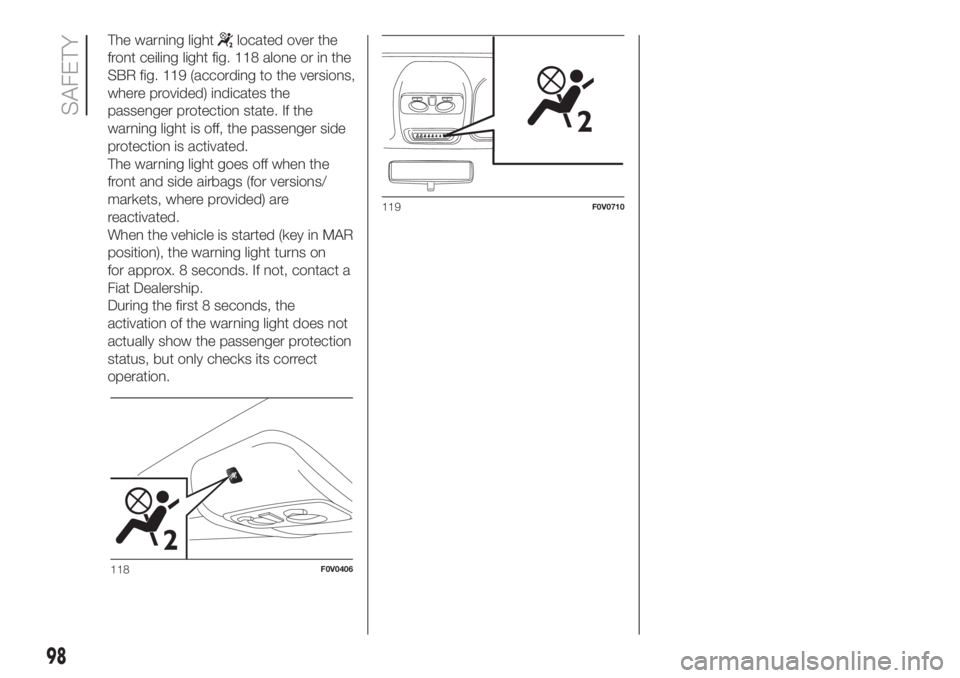
The warning lightlocated over the
front ceiling light fig. 118 alone or in the
SBR fig. 119 (according to the versions,
where provided) indicates the
passenger protection state. If the
warning light is off, the passenger side
protection is activated.
The warning light goes off when the
front and side airbags (for versions/
markets, where provided) are
reactivated.
When the vehicle is started (key in MAR
position), the warning light turns on
for approx. 8 seconds. If not, contact a
Fiat Dealership.
During the first 8 seconds, the
activation of the warning light does not
actually show the passenger protection
status, but only checks its correct
operation.
118F0V0406
119F0V0710
98
SAFETY
Page 102 of 272

WARNING
77)Do not apply stickers or other objects to the steering wheel, the dashboard in the passenger side airbag area and the seats. Never put
objects (e.g. mobile phones) on the passenger side of the dashboard since they could interfere with correct inflation of the passenger airbag
and also cause serious injury to the passengers.
78)Always drive with your hands on the rim of the steering wheel so that the airbag can inflate freely if required. Do not drive bent over the
steering wheel, but rather sit upright with your back firmly resting against the seat back.
79)The airbag deployment threshold is higher than that of the pretensioners. For collisions in the range between the two thresholds, it is
normal for only the pretensioners to be activated.
80)The airbag does not replace seat belts but increases their efficiency. Because front airbags are not deployed for low-speed crashes, side
collisions, rear-end shunts or rollovers, occupants are protected, in addition to any side bags, only by their seat belts, which must therefore
always be fastened.
81)In some versions, in the event of a failure of the
LED (located on the front ceiling light), thewarning light on the instrument panel
turns on and the passenger side airbags are deactivated.
82)When there is an active passenger airbag, DO NOT install rearward facing child restraint systems on the front seat. Deployment of the
airbag in a crash could cause fatal injuries to the child regardless of the severity of the collision. Therefore, always deactivate the passenger
side airbag when a rearward facing child restraint system is installed on the front passenger seat. The front passenger seat must also be
positioned back as far as possible in order to prevent the child restraint system from coming into contact with the dashboard. Immediately
reactivate the passenger airbag as soon as the child restraint system has been removed.
100
SAFETY
Page 104 of 272
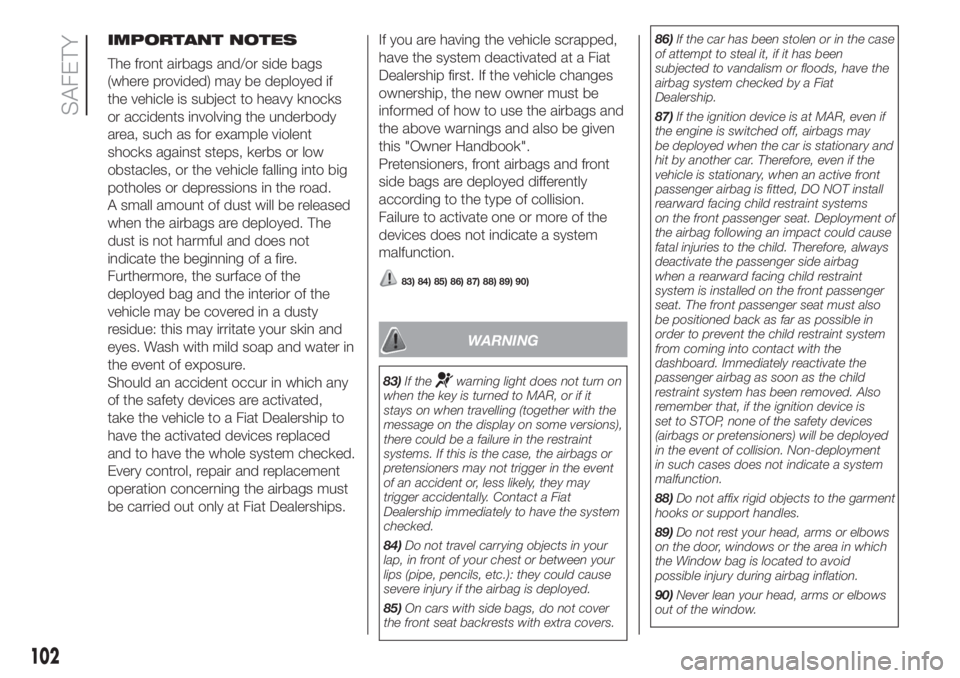
IMPORTANT NOTES
The front airbags and/or side bags
(where provided) may be deployed if
the vehicle is subject to heavy knocks
or accidents involving the underbody
area, such as for example violent
shocks against steps, kerbs or low
obstacles, or the vehicle falling into big
potholes or depressions in the road.
A small amount of dust will be released
when the airbags are deployed. The
dust is not harmful and does not
indicate the beginning of a fire.
Furthermore, the surface of the
deployed bag and the interior of the
vehicle may be covered in a dusty
residue: this may irritate your skin and
eyes. Wash with mild soap and water in
the event of exposure.
Should an accident occur in which any
of the safety devices are activated,
take the vehicle to a Fiat Dealership to
have the activated devices replaced
and to have the whole system checked.
Every control, repair and replacement
operation concerning the airbags must
be carried out only at Fiat Dealerships.If you are having the vehicle scrapped,
have the system deactivated at a Fiat
Dealership first. If the vehicle changes
ownership, the new owner must be
informed of how to use the airbags and
the above warnings and also be given
this "Owner Handbook".
Pretensioners, front airbags and front
side bags are deployed differently
according to the type of collision.
Failure to activate one or more of the
devices does not indicate a system
malfunction.
83) 84) 85) 86) 87) 88) 89) 90)
WARNING
83)If thewarning light does not turn on
when the key is turned to MAR, or if it
stays on when travelling (together with the
message on the display on some versions),
there could be a failure in the restraint
systems. If this is the case, the airbags or
pretensioners may not trigger in the event
of an accident or, less likely, they may
trigger accidentally. Contact a Fiat
Dealership immediately to have the system
checked.
84)Do not travel carrying objects in your
lap, in front of your chest or between your
lips (pipe, pencils, etc.): they could cause
severe injury if the airbag is deployed.
85)On cars with side bags, do not cover
the front seat backrests with extra covers.86)If the car has been stolen or in the case
of attempt to steal it, if it has been
subjected to vandalism or floods, have the
airbag system checked by a Fiat
Dealership.
87)If the ignition device is at MAR, even if
the engine is switched off, airbags may
be deployed when the car is stationary and
hit by another car. Therefore, even if the
vehicle is stationary, when an active front
passenger airbag is fitted, DO NOT install
rearward facing child restraint systems
on the front passenger seat. Deployment of
the airbag following an impact could cause
fatal injuries to the child. Therefore, always
deactivate the passenger side airbag
when a rearward facing child restraint
system is installed on the front passenger
seat. The front passenger seat must also
be positioned back as far as possible in
order to prevent the child restraint system
from coming into contact with the
dashboard. Immediately reactivate the
passenger airbag as soon as the child
restraint system has been removed. Also
remember that, if the ignition device is
set to STOP, none of the safety devices
(airbags or pretensioners) will be deployed
in the event of collision. Non-deployment
in such cases does not indicate a system
malfunction.
88)Do not affix rigid objects to the garment
hooks or support handles.
89)Do not rest your head, arms or elbows
on the door, windows or the area in which
the Window bag is located to avoid
possible injury during airbag inflation.
90)Never lean your head, arms or elbows
out of the window.
102
SAFETY
Page 106 of 272
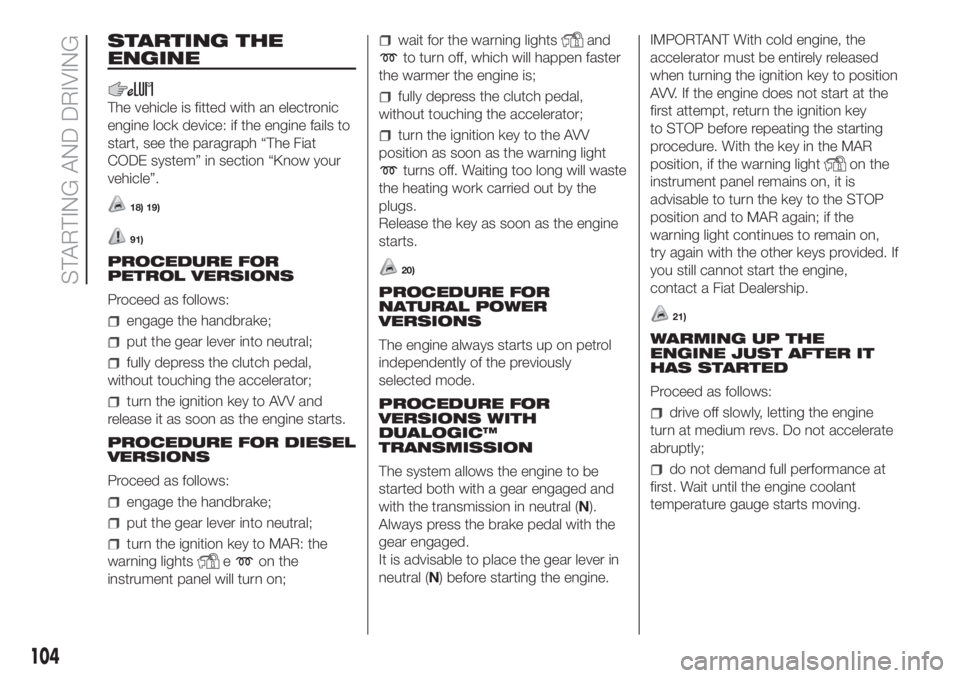
STARTING THE
ENGINE
The vehicle is fitted with an electronic
engine lock device: if the engine fails to
start, see the paragraph “The Fiat
CODE system” in section “Know your
vehicle”.
18) 19)
91)
PROCEDURE FOR
PETROL VERSIONS
Proceed as follows:
engage the handbrake;
put the gear lever into neutral;
fully depress the clutch pedal,
without touching the accelerator;
turn the ignition key to AVV and
release it as soon as the engine starts.
PROCEDURE FOR DIESEL
VERSIONS
Proceed as follows:
engage the handbrake;
put the gear lever into neutral;
turn the ignition key to MAR: the
warning lights
eon the
instrument panel will turn on;
wait for the warning lightsand
to turn off, which will happen faster
the warmer the engine is;
fully depress the clutch pedal,
without touching the accelerator;
turn the ignition key to the AVV
position as soon as the warning light
turns off. Waiting too long will waste
the heating work carried out by the
plugs.
Release the key as soon as the engine
starts.
20)
PROCEDURE FOR
NATURAL POWER
VERSIONS
The engine always starts up on petrol
independently of the previously
selected mode.
PROCEDURE FOR
VERSIONS WITH
DUALOGIC™
TRANSMISSION
The system allows the engine to be
started both with a gear engaged and
with the transmission in neutral (N).
Always press the brake pedal with the
gear engaged.
It is advisable to place the gear lever in
neutral (N) before starting the engine.IMPORTANT With cold engine, the
accelerator must be entirely released
when turning the ignition key to position
AVV. If the engine does not start at the
first attempt, return the ignition key
to STOP before repeating the starting
procedure. With the key in the MAR
position, if the warning light
on the
instrument panel remains on, it is
advisable to turn the key to the STOP
position and to MAR again; if the
warning light continues to remain on,
try again with the other keys provided. If
you still cannot start the engine,
contact a Fiat Dealership.
21)
WARMING UP THE
ENGINE JUST AFTER IT
HAS STARTED
Proceed as follows:
drive off slowly, letting the engine
turn at medium revs. Do not accelerate
abruptly;
do not demand full performance at
first. Wait until the engine coolant
temperature gauge starts moving.
104
STARTING AND DRIVING
Page 107 of 272
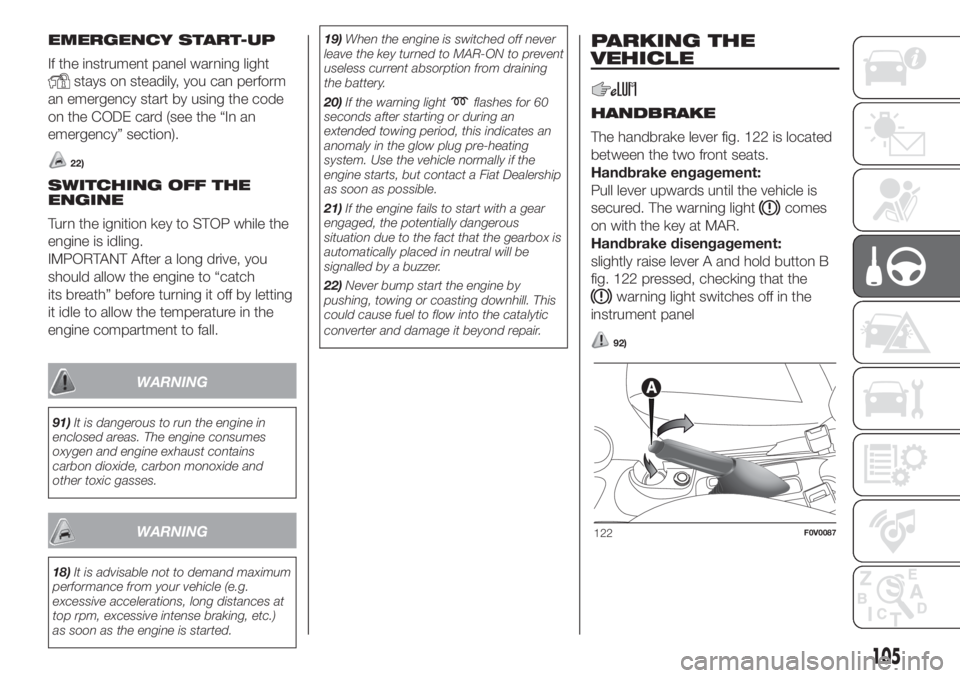
EMERGENCY START-UP
If the instrument panel warning light
stays on steadily, you can perform
an emergency start by using the code
on the CODE card (see the “In an
emergency” section).
22)
SWITCHING OFF THE
ENGINE
Turn the ignition key to STOP while the
engine is idling.
IMPORTANT After a long drive, you
should allow the engine to “catch
its breath” before turning it off by letting
it idle to allow the temperature in the
engine compartment to fall.
WARNING
91)It is dangerous to run the engine in
enclosed areas. The engine consumes
oxygen and engine exhaust contains
carbon dioxide, carbon monoxide and
other toxic gasses.
WARNING
18)It is advisable not to demand maximum
performance from your vehicle (e.g.
excessive accelerations, long distances at
top rpm, excessive intense braking, etc.)
as soon as the engine is started.19)When the engine is switched off never
leave the key turned to MAR-ON to prevent
useless current absorption from draining
the battery.
20)If the warning light
flashes for 60
seconds after starting or during an
extended towing period, this indicates an
anomaly in the glow plug preheating
system. Use the vehicle normally if the
engine starts, but contact a Fiat Dealership
as soon as possible.
21)If the engine fails to start with a gear
engaged, the potentially dangerous
situation due to the fact that the gearbox is
automatically placed in neutral will be
signalled by a buzzer.
22)Never bump start the engine by
pushing, towing or coasting downhill. This
could cause fuel to flow into the catalytic
converter and damage it beyond repair.
PARKING THE
VEHICLE
HANDBRAKE
The handbrake lever fig. 122 is located
between the two front seats.
Handbrake engagement:
Pull lever upwards until the vehicle is
secured. The warning light
comes
on with the key at MAR.
Handbrake disengagement:
slightly raise lever A and hold button B
fig. 122 pressed, checking that the
warning light switches off in the
instrument panel
92)
122F0V0087
105
Page 108 of 272
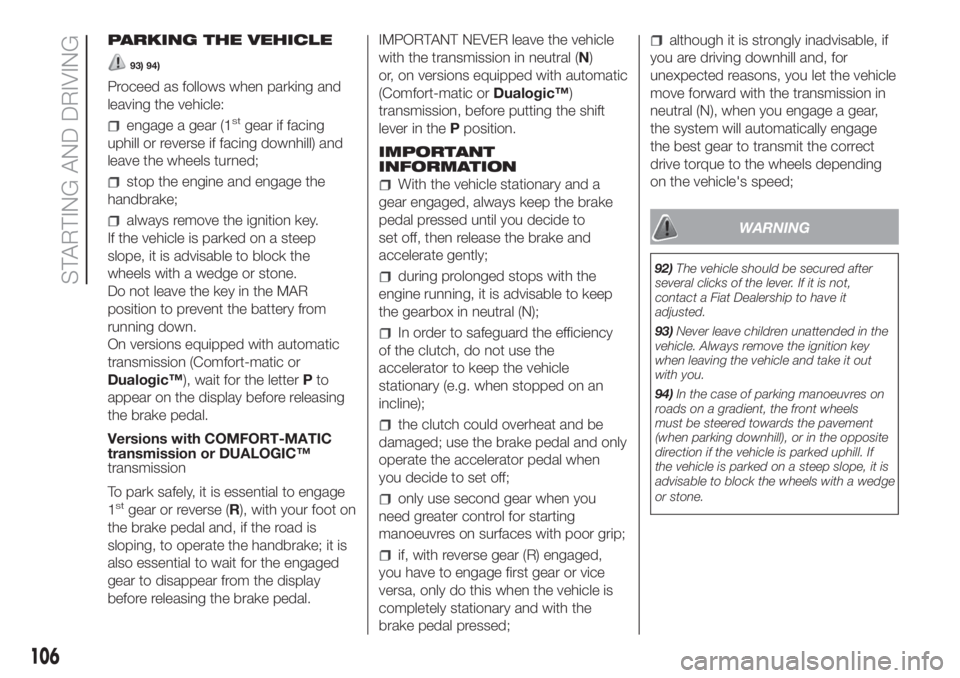
PARKING THE VEHICLE
93) 94)
Proceed as follows when parking and
leaving the vehicle:
engage a gear (1stgear if facing
uphill or reverse if facing downhill) and
leave the wheels turned;
stop the engine and engage the
handbrake;
always remove the ignition key.
If the vehicle is parked on a steep
slope, it is advisable to block the
wheels with a wedge or stone.
Do not leave the key in the MAR
position to prevent the battery from
running down.
On versions equipped with automatic
transmission (Comfort-matic or
Dualogic™), wait for the letterPto
appear on the display before releasing
the brake pedal.
Versions with COMFORT-MATIC
transmission or DUALOGIC™
transmission
To park safely, it is essential to engage
1
stgear or reverse (R), with your foot on
the brake pedal and, if the road is
sloping, to operate the handbrake; it is
also essential to wait for the engaged
gear to disappear from the display
before releasing the brake pedal.IMPORTANT NEVER leave the vehicle
with the transmission in neutral (N)
or, on versions equipped with automatic
(Comfort-matic orDualogic™)
transmission, before putting the shift
lever in thePposition.
IMPORTANT
INFORMATION
With the vehicle stationary and a
gear engaged, always keep the brake
pedal pressed until you decide to
set off, then release the brake and
accelerate gently;
during prolonged stops with the
engine running, it is advisable to keep
the gearbox in neutral (N);
In order to safeguard the efficiency
of the clutch, do not use the
accelerator to keep the vehicle
stationary (e.g. when stopped on an
incline);
the clutch could overheat and be
damaged; use the brake pedal and only
operate the accelerator pedal when
you decide to set off;
only use second gear when you
need greater control for starting
manoeuvres on surfaces with poor grip;
if, with reverse gear (R) engaged,
you have to engage first gear or vice
versa, only do this when the vehicle is
completely stationary and with the
brake pedal pressed;
although it is strongly inadvisable, if
you are driving downhill and, for
unexpected reasons, you let the vehicle
move forward with the transmission in
neutral (N), when you engage a gear,
the system will automatically engage
the best gear to transmit the correct
drive torque to the wheels depending
on the vehicle's speed;
WARNING
92)The vehicle should be secured after
several clicks of the lever. If it is not,
contact a Fiat Dealership to have it
adjusted.
93)Never leave children unattended in the
vehicle. Always remove the ignition key
when leaving the vehicle and take it out
with you.
94)In the case of parking manoeuvres on
roads on a gradient, the front wheels
must be steered towards the pavement
(when parking downhill), or in the opposite
direction if the vehicle is parked uphill. If
the vehicle is parked on a steep slope, it is
advisable to block the wheels with a wedge
or stone.
106
STARTING AND DRIVING